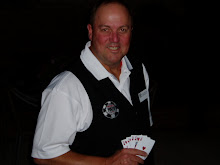 |
| All in, all in and call |
One of the challenges facing the "Part Time" dealer is keeping one's whits about when complex situations arise. Much like Timmy Louie's five-way all in pot, I had a three/four way pot with an all in and a folded hand with money in the side pot that was tough to figure out. Actually, when sitting at a desk and analyzing it, the solution seems simple and straightforward, but it becomes difficult when in the heat of the moment, under pressure to get it right and with at least three different players shouting out different suggestions of how to handle it (inevitable with some of them simply incorrect).
Here is how the situation unfolded:
Big pot, all in situation. Large stack versus large stack. Exciting hand with people standing up around the table watching as the cards come out, the winner being declared and then the stacks being counted down to see if the loser is out or has chips left. End result was the loser had 1200 left. For the next hand, the ante was 400 and the blinds were 1500 and 3000. The loser was in the small blind, so after putting in his 400 ante, he had 800 left and was all in for less than the required small blind.
Now, an experienced dealer would immediately recognize the situation and see that whatever happens in the hand, the big blind will need to be split or changed up because only 800 of the 3000 will go into the main pot - to cover the all in player's bet. The rest will go into a side pot and be contested by others in the pot. This is easy to see looking back, but a little tougher in the midst of a new hand in the aftermath of a big emotional showdown.
A middle position player with a deep stack then makes a raise to 8700 which is followed by a fold and an all in re-raise. The big blind player folds and the raiser asks that the bets be pulled in so he can see how much it is to call. The bets needed to be pulled into a side pot because of the short stack all in player. The raiser says, "OK, I call." And all hell breaks loose as three different players start shouting instructions to the dealer as to how to handle the side pot including one who insists we simply deal out the cards and figure out who wins what later (which is not an option in a tournament situation). Another is shouting, "Just take out the eleven-four. Just take out the eleven-four!" Which makes no sense to me at all.
Eventually, the light goes on in my head when a player points out that only 800 of the big blind should go into the main pot. I then make change and take the 800 in from the big blind, the all in small blind, 1600 from the bets taken in (which I kept separate) to determine the call into the main pot, then I place the remainder of the big blind in front of the first all in player as a side pot, which actually also includes the bets taken in plus the remainder of the second all in player's stack. People are still shouting instructions and amounts but I pause and quickly explain, "This is the main pot that he is in for," indicating the short stack. "The rest is on the side between these two players," knowing that if the second all in player wins, the deep stack must pay the remainder, while if the deeper stack wins, the side pot including the chips in front of the larger all in player will be shipped.
Burn and Turn, burn and River. The second all in player wins it all with pocket Aces, the short stack mucks his losing hand and leaves the table and the pots are paid. Whew!
It was confusing. This is where dealer experience pays off. The longer you deal, the more situations you run into where short stacks go all in and side pots need to be created. I can't recall any situation this year where I had a player all in for less than the big blind. The subsequent raise and re-raise with a request to pull in the bets created additional complexity with the multiple all in, side pot scenario. Yes, eventually I sorted it all out and got all the pots right. In the future, I will be more confident and will be able to control the table more effectively.
Aftermath: It took me until the next morning to figure out what the "eleven-four" was. He incorrectly was thinking that because the big blind was 3000, it was in the main pot along with 3000 from each of the deeper stacks. Eleven-four represented what was remaining of the 8700 raise that was taken in from each of the two larger stacks less 3000 from each for the big blind. This was incorrect because only 800 of the big blind went into the main pot while 2200 went into the side pot. Thinking along those lines, eleven-four should have been "fourteen-eight" but from my perspective, rather than doing the math I was better off setting the chips up and then taking in 800 from each and creating the side pot with the remainder.
A really good dealer can do the math and move the chips amid lots of shouting of different numbers and sometimes incorrect instructions from several players, do it confidently, handle the pressure, control the players and the situation and get it all done right taking a minimal amount of time to do it. That is when a dealer is earning his money.





